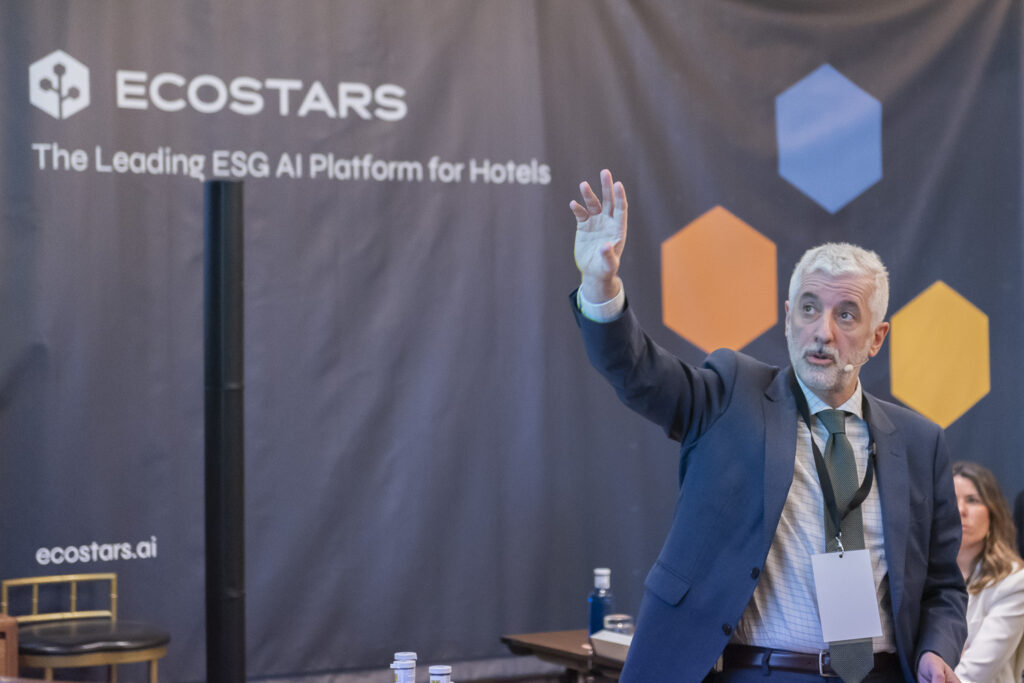If you think the Corporate Sustainability Reporting Directive (CSRD) is just another layer of bureaucracy, think again.
The CSRD is the most ambitious sustainability disclosure regulation ever introduced in Europe. And it’s not here to tick boxes. It’s here to force a new standard of transparency, accountability, and data integrity — backed by law, enforced with audits, and measured in machine-readable formats.
Yet most companies are preparing for it with outdated tools, manual surveys, and siloed data. That’s a recipe for frustration and non-compliance.
At Ecostars, we’re building a smarter path forward — powered by AI, designed for hotel chains, and built for real-world complexity.
But first, let’s unpack what CSRD really means.
What Is CSRD and Why Does It Matter?
The CSRD is the EU’s bold move to turn sustainability from marketing to metrics. Replacing the old Non-Financial Reporting Directive (NFRD), CSRD applies to nearly 50,000 companies — making ESG reporting as rigorous as financial disclosure.
At its core are three pillars:
- The European Sustainability Reporting Standards (ESRS), developed by EFRAG
- A strict double materiality requirement
- Reports delivered in XBRL (machine-readable) format, ready for digital analysis by investors and regulators
CSRD isn’t about what you say — it’s about what you prove. With structured data.
What’s in the ESRS?
The ESRS framework breaks ESG into:
- Cross-cutting standards (e.g., general principles, strategy, materiality)
- Topical standards across:
- Environment (E1-E5: climate change, pollution, water, biodiversity, circularity)
- Social (S1-S4: workforce, consumers, communities, value chain)
- Governance (G1: conduct, corruption, internal controls)
In total, you’re looking at 1,000+ disclosure datapoints — many of which are mandatory if deemed material.
The CSRD Timeline (Including the Omnibus Update)
The CSRD rollout is happening in waves:
| Company Type | Reporting Starts | Reporting Year | Data Year Covered |
|---|---|---|---|
| EU large public interest entities | Jan 2025 | FY 2024 | 2024 |
| Large EU companies (2 of: >250 employees, €40M turnover, €20M assets) | Jan 2026 | FY 2025 | 2025 |
| Listed SMEs (opt-out until 2028) | Jan 2027 | FY 2026 | 2026 |
The 2024 “Omnibus Directive” update introduced clarifications and phased transitions, but the core expectation remains: complete, auditable, and standardized sustainability reports — by law.
Why Double Materiality Is the Cornerstone
Before you even think of drafting a report, CSRD demands a double materiality assessment. This determines:
- Impact materiality: How your business affects the world (e.g., emissions, labor practices)
- Financial materiality: How ESG factors affect your business (e.g., climate risk, regulation)
If a topic is material on either side, it must be reported. That’s how your reporting scope is defined — no shortcuts.
The Final Deliverables: More Than Just a Report
Under CSRD, your sustainability disclosure must include:
- A detailed narrative report (integrated or standalone)
- A digital file in XBRL format, based on the EFRAG taxonomy
Why XBRL? Because it enables real-time, machine-readable analysis — regulators, investors, and AI models can extract your sustainability performance just like financial data.
How We Do It at Ecostars — Without the Manual Work
Let’s face it: no hotel chain has time to compile 1,000+ indicators across dozens of properties, markets, and data systems — then wrap it all into an XBRL document.
That’s where we come in.
🧠 AI-Powered Materiality Assessment
We use generative AI and contextual algorithms to automatically assess what matters for your hotel — and why. Our model integrates:
- Hotel location and geospatial risk
- World news and regulatory updates affecting your market
- Customer sentiment from reviews and feedback
- Utility consumption, PMS data, internal HR and finance metrics
- Natural disasters, economic shifts, political trends — the full external context
Result: A living, auditable materiality map for every hotel, or rolled up by chain, country, or region.
🔌 Automatic Aggregation Across Data Sources
We connect directly to:
- Utility providers
- PMS and ERP systems
- Internal operational data
- Verified external datasets
No spreadsheets. No endless email chains. Just clean, contextualized data, ready for reporting.
📄 Audit-Ready, Instant Reports + XBRL Output
We generate:
- A complete narrative sustainability report, fully CSRD-aligned
- A parallel XBRL file using the official ESRS taxonomy
Need it per hotel? Per country? Per brand within the chain? Done.
And because it’s AI-driven, your reports evolve as your data does — not once a year, but continuously.
The Old Way vs. Ecostars
| Legacy Tools | Ecostars | |
|---|---|---|
| Materiality Process | Manual workshops, spreadsheets | AI-driven, news-aware, auto-refreshed |
| Data Aggregation | Siloed and static | Real-time, multi-source |
| Report Generation | Manual copy-paste | Auto-generated with GenAI |
| Format Output | PDF or Word | PDF + CSRD-compliant XBRL |
| Scalability | Painful | By hotel, region, or whole chain |
Final Thought: CSRD Is Not a Burden — It’s a Competitive Advantage
The companies that win in the next decade will be the ones that treat ESG not as a compliance headache, but as a source of truth and strategy.
CSRD is forcing the change. Ecostars is making it frictionless.
Ready to transform your sustainability reporting from chaos to clarity?
